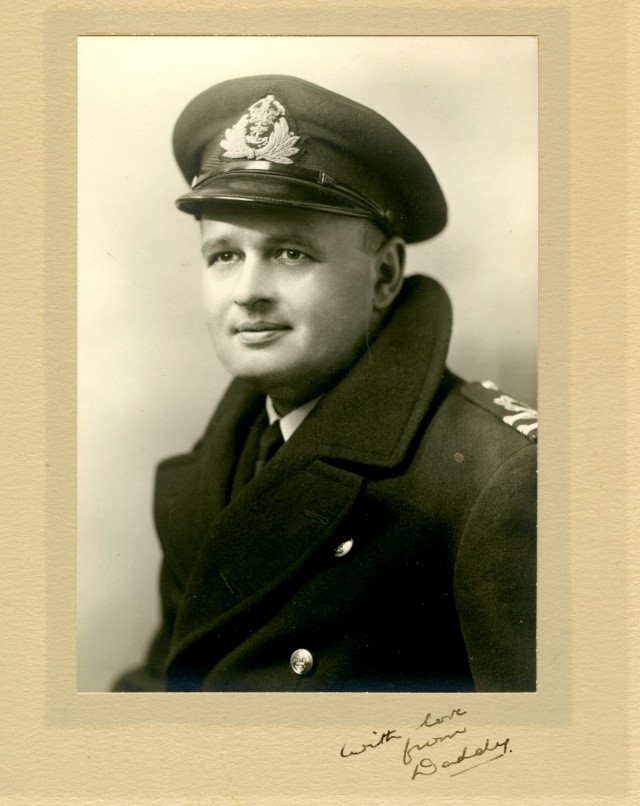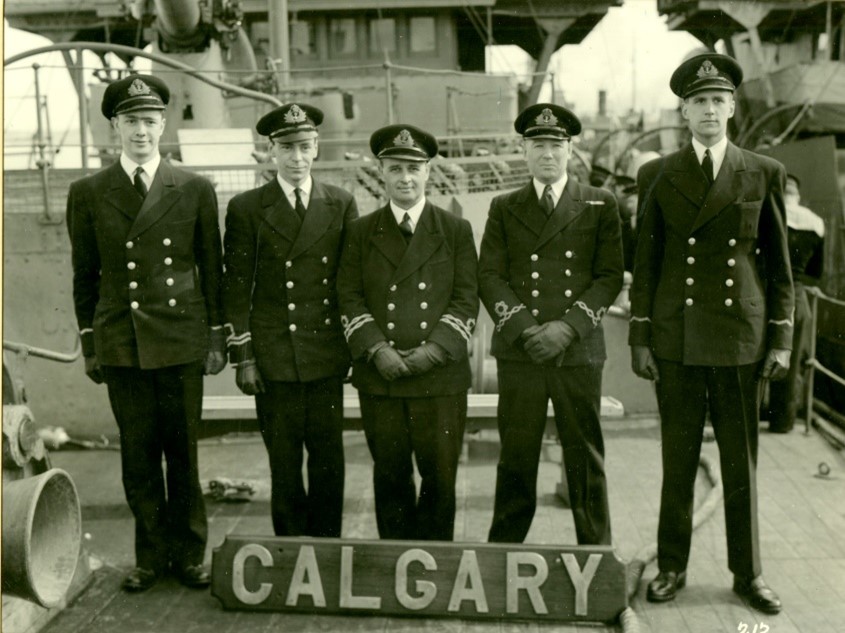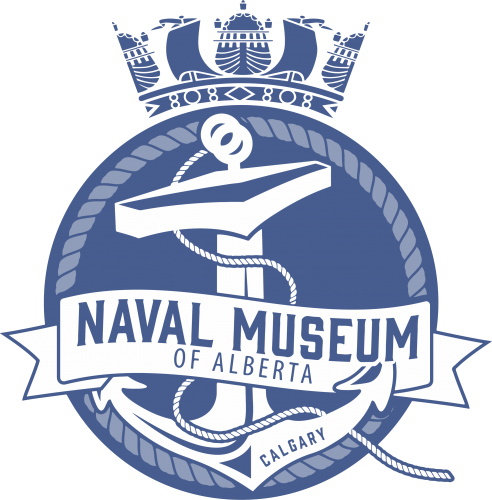Commander Gerald Lancaster CD, RCNR
September 21st 2022
Merchant Seaman
First Commanding Officer of HMCS Calgary K231
The Naval Museum of Alberta recently received artefacts and documents related to the naval career of CDR Gerald Lancaster RCNR from his son, John Lancaster of Saltspring Island, BC. Cdr. Lancaster served the Canadian Navy in war and peacetime appointments forms for over 25 years.
What makes CDR. Lancaster’s story unique is his commitment throughout his life to his profession, and his country, the Naval Reserve, and his community.
CDR Lancaster was the first Commanding Officer of HMCS Calgary (K231) from its commissioning as Sorel, Quebec in December of 1941, through to convoy duties until 1942.

Lt. Gerald Lancaster RCNR during the Second World War. Image: Naval Museum of Alberta
His Story
Born in South Africa, June 2, 1903, “Gerry” acquired an early affinity for the sea, making his first voyage when he was only one year old. By the age of five he had crossed the equator three times.Gerry began his sea career as a seventeen-year-old trainee Midshipman Apprentice with the Alfred Holt and Company/Blue Funnel Line in 1920. Upon completion of his four-year apprenticeship, he easily passed his Second Mate’s Certificate and was hired back as an officer with the Blue Funnel Line, later passing his Foreign-Going Master’s Certificate.
In 1930, at age 27, Gerry immigrated to Canada, arriving at the Port of Vancouver in the middle of the depression. Within ten days he got a job as a deckhand on the ferry system that operated between downtown Vancouver and the municipality of West Vancouver, rising to Master.
The Second World War
In 1938 when it was evident that war was looming, and with fear that the conflict might become global, Gerry wrote a letter to Naval Service Headquarters volunteering his services, as he believed his experience at sea would be valuable. In response, the Naval Service thanked him, adding: “we already have your name but at the present time we have no need of your services and will let you know if we do.” It wasn’t until 29 March 1940 that he was instructed to report for duty with the RCNR at Esquimalt on April 1st. Indeed, his experience would prove to be most useful.The class he joined at “basic training” in at Esquimalt consisted entirely of Merchant Seamen, all holding Foreign-Going Master’s certificates, and all with the rank of Lieutenant RCNR. Members of the Royal Canadian Naval Reserve (RCNR) were professional sailors by trade, unlike those of the RCNVR who were civilians that were taught their seafaring skills.

HMCS Calgary Bridge Officers. L to R: S/Lt Alan Welch RCNVR, Lt. Guy Mongenais RCNVR, Lt. Gerry Lancaster RCNR, C.O., Mate Ernest Wilson RCNR, S/Lt Peter Charles RCNVR. Sadly, Lt. Ernest Wilson was killed in the sinking of HMCS Louisburg 6 February 1943. Image: Naval Museum of Alberta.
Following training at Naden, Yorke Island, (where he took his Command Course), Givenchy, and Stadacona, he was appointed Commanding Officer of HMCS Calgary, where he led the ship through workups, mechanical issues, then on to convoy duty in the Atlantic which included an engagement with an enemy U-boat.
Cdr. Lancaster’s Command of Calgary was cut short due to health issues which would not only put him in hospital but threatened to have him released from the Navy. On recovery, and after having a few “strings pulled” through senior officers with which he was acquainted, he was appointed to HMCS Kings (Halifax) as Navigation Instructor from Sept. 1942 to Dec. 1943.
In December of 1943, Gerry was transferred to the Naval Control of Shipping (NCOS) Organization as routing Officer in St. John’s Newfoundland. This started a part of his career in which he was actively involved with for the rest of his naval service.
In March of 1944 Gerry was appointed to as a NCOS routing officer in Vancouver, and in 1945 was appointed the NCOS Officer in charge with the rank of Lieutenant-Commander, where he served until the office was closed in 1946. He then returned to civilian life after five years and ten months on active naval service.

Image titled: "What do you think of our crest designed and painted by No. 1” (X.O. Lt. Guy Mongenais) Image: Naval Museum of Alberta.
Post-war
In 1947, Gerry decided to join the Naval Reserve Division at HMCS Discovery where he served as Navigation Instructor, though outside of the Division he had another appointment of Merchant Navy Liaison Officer. He participated in NCOS exercises (at least once as Commodore) and conferences Often sometimes as speaker. In January of 1951 he was promoted to Commander and received the Canadian Forces Decoration in 1952.
N.C.S.O. Exercise in St. John's 1966. CDR Lancaster 2nd from right. Image: Naval Museum of Alberta
Gerry became Vancouver Harbour Master in 1946. In his first year he re-wrote and updated the Harbour Bylaws. During his tenure, he fought to get radar installed at Vancouver Harbour (the second harbour in the world, after Liverpool), instigated a ship fire-fighting course for city firemen (the first in the world), was vice-chair of the committee to prepare a Harbour Disaster Program, and was a speaker on harbour safety/handling of dangerous goods.
Following his retirement from the Harbours Board, he became an officer on B.C. Ferries. Later, at the request of the B.C. Government, he started college courses for professional mariners for various marine certificates of competency, both creating the curriculum and developing and teaching courses.
Gerry was a member of the Honourable Company of Master Mariners when its membership was limited to 600 worldwide, and a foundation member of the Master Mariners of Canada. As a board member of the Canadian Merchant Service Guild, he was chair of committee to make recommendations for revision to the Canada Shipping Act. He was awarded its first ever honorary membership under their bylaw requirements to resign on becoming Harbour Master. He was a foundation member of the Nautical Institute (London), wrote articles for their journal, and was later elected to a Fellowship.
Gerry was a speaker on the History of the Port of Vancouver for service clubs and other organizations. He was a member and officer of Toc H (Talbot House), personally instigating the first case of free blood transfusions in Vancouver, and possibly Canada.
He served as president of West Vancouver Credit Union; on two committees of the Community Chest; a member of the Royal Canadian Legion; coached the West Vancouver Rugby team; president of the North Shore Rugby Union for one year; and a member of the committee of the North Vancouver Sea Cadets.
Gerry was active in the Missions to Seafarers (then known as the Mission to Seamen) as Board Chair for six years, chair of the Men’s Committee for eight years and chair of the Building Committee for three. He would even at times invite merchant marine seamen to his house for a home-cooked dinner.
The Collection
Commander Gerry Lancaster passed away in 1982. His ashes were scattered in the Strait of Juan de Fuca off Victoria, off Constance Bank. Among the collection donated to the Naval Museum by his son are many photographs taken during his career including some unique images of HMCS Calgary, letters, convoy orders, messages, and a biography originally written by Cdr. Lancaster and edited by his son John, from which this information was extracted.Of note in his biography is an insightful history of the organization of Naval Control of Shipping during the Second World War
The Naval Museum of Alberta is indeed grateful to have been given this important collection.
Naval Museum of Alberta
Bradley S. Froggatt, Curator

Click to close
